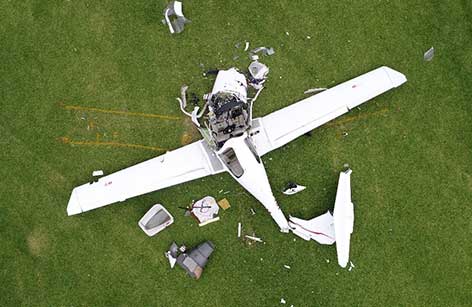Some flying training organisations may be conducting incipient spin training in aircraft not approved for intentional spinning, an Australian Transport Safety Bureau (ATSB) investigation into a fatal training accident has found. Depending on the aircraft type, the manufacturer may not have specified whether that restriction applies to an incipient spin or only a developed spin.

A new Safety Advisory Notice issued by the ATSB advises flying training organisations using aircraft not approved for intentional spinning to clarify with aircraft manufacturers the extent to which the intentional entry into the early stages of a spin, including an incipient spin, spin is permissible.
The accident occurred on 26 September 2017, during a Recreational Pilot Licence practice flight test. The instructor and student took off from Archerfield Airport, south-west of Brisbane, Queensland, in a Diamond Aircraft DA40. Radar data showed the aircraft commenced a climb to about 4,500 ft with a reducing groundspeed, consistent with stall recovery training. The data then showed the aircraft’s flight path to be a near vertical descent with an average descent rate of about 6,000 feet per minute.
The aircraft collided with terrain, with the impact destroying the aircraft and fatally injuring the instructor and student.
The ATSB’s investigation found the instructor and the student were likely conducting advanced stall recovery training – a lesson which probably included intentionally initiating incipient spins (the early stage of a spin). The investigation also found that the instructor could not or did not prevent the aircraft from entering a developed spin from an incipient spin, for reasons that could not be established.
The aircraft manufacturer advised that the DA40’s limitation prohibiting intentional spins was intended to include incipient spins. However, the incipient spin manoeuvre was not defined and some operators considered that an incipient spin was not an intentional spin.
While the Civil Aviation Safety Authority (CASA) requires the demonstration of recovery from an incipient spin during flight tests, there is no clear and consistent definition of the point at which a manoeuvre becomes a spin – or incipient spin – for the purposes of flying training.
The investigation also identified incorrect incipient spin recovery guidance had been provided by CASA in its Flight Instructor Manual. The Authority says it will review its guidance material.
“The ATSB is calling for flying training organisations using aircraft not approved for intentional spinning to clarify with their aircraft manufacturer the extent to which the intentional entry into the early stages of a spin, including an incipient spin, is permissible and ensure that their aircraft are always operated in accordance with limitations,” ATSB Executive Director, Transport Safety Mr Nat Nagy said.
“Furthermore, operators should have procedures, and instructors should take all steps, to ensure that they maintain the necessary skills to avoid unintentional spins and recover from both incipient and developed spins.”
Read the Safety Advisory Notice AO‑2017‑096‑SAN-012: Is incipient spin training permitted in your aircraft?
Read the report: Collision with terrain involving Diamond DA40, VH-MPM, 42 km west of Southport Aerodrome, Queensland, on 26 September 2017
For additional reading, the New Zealand Civil Aviation Authority booklet Spin Avoidance and Recovery provides valuable guidance for pilots in spin avoidance and recovery. The booklet provides the following advice for pilots regarding spin recovery:
To have a chance at recovery, the pilot must immediately recognise the spin, and its direction, know exactly what to do in the right order, and then execute the procedure correctly the first time.


